|
First
published in the "Quarterly Journal of Science", January 1st 1871
TWELVE MONTHS ago in this journal I wrote an article, which, after expressing in
the most emphatic manner my belief in the occurrence, under certain circumstances, of phenomena inexplicable by any known natural laws, I indicated several tests which men of science had a right to demand before giving credence to the genuineness of these phenomena. Among the tests pointed out were, that a "delicately poised balance should be moved under test conditions"; and that some exhibition of power equivalent to so many "foot-pounds" should be manifested in his laboratory, where the experimentalists could weigh measure, and submit to it proper tests." I said, too, that I could not promise to enter fully into this subject, owing to the difficulties of obtaining opportunities, and the numerous failures attending the enquiry; moreover, that "the persons in whose presence these phenomena take place are few in number, and opportunities for experimenting with previously arranged apparatus are rarer still."
Opportunities having since offered for pursuing the investigation, I have gladly availed myself of them for applying to these phenomena careful scientific testing experiments and I have thus arrived at certain definite results which I think it right should be published. These experiments appear conclusively to establish the existence of a new force, in some unknown manner connected with the human organization, which for convenience may be called the Psychic Force.
Of all the persons endowed with a powerful development of this Psychic Force, and who have been termed "mediums" upon quite another theory of its origin, Mr. Daniel Douglas Home is the most remarkable, and it is mainly owing to the many opportunities I have had of carrying on my investigation in his presence that I am enabled to affirm so conclusively the existence of this Force. The experiments I have tried have been very numerous, but owing to our imperfect knowledge of the conditions which favor or oppose the manifestations of this force, to the apparently capricious manner in which it is exerted, and to the fact that Mr. Home himself is subject to unaccountable ebbs and flows of the force, it has but seldom happened that a result obtained on one occasion could be subsequently confirmed and tested with apparatus specially contrived for the purpose.
Among the remarkable phenomena which occur under Mr. Home's influence, the most striking, as well as the most easily tested with scientific accuracy,
are - (1) the alteration in the weight of bodies, and (2) the playing of tunes upon musical instruments (generally an accordion, for convenience of portability) without direct human intervention, under conditions rendering contact or connection with the keys impossible. Not until I had witnessed these facts some half-dozen times, and scrutinized them with all the critical acumen I possess, did I become convinced of their objective reality. Still, desiring to place the matter beyond the shadow of doubt, I invited Mr. Home on several occasions to come to my own house, where, in the presence of a few scientific enquirers, these phenomena could be submitted to crucial
experiments.
The meetings took place in the evening, in a large room lighted by gas. The apparatus prepared for the purpose of testing the movements of the accordion, consisted of a cage, formed of two wooden hoops, respectively 1 foot 10 inches and 2 feet diameter, connected together by 12 narrow laths, each 1 foot 10 inches long, so as to form a drum-shaped frame, open at the top and bottom; round this 50 yards of insulated copper wire were wound in 24 rounds, each being rather less than an inch from its neighbour. The horizontal strands of wire were then netted together firmly with string, so as to form meshes rather less than 2 inches long by 1 inch high. The height of this cage was such that it would just slip under my dining table, but be too close to the top to allow of the hand being introduced into the interior, or to admit of a foot being pushed underneath it. In another room were two Grove's cells, wires being led from them into the dining room for connection, if desirable, with the wires surrounding the cage.
The accordion was a new one, having been purchased by myself for the purpose of these experiments at Wheatstone's, in Conduit Street. Mr. Home had neither handled nor seen the instrument before the commencement of the test experiments.
In another part of the room an apparatus was fitted up for experimenting on the alterations in the weight of a body. It consisted of a mahogany board, 36 inches long by
9 1/2 inches wide and 1 inch thick. At each end a strip of mahogany 1 1/2 inches wide was screwed on, forming feet. One end of the board rested on a firm table, whilst the other end was supported by a spring balance hanging from a substantial tripod stand. The balance was fitted with a self-registering index, in such a manner that it would record the maximum weight indicated by the pointer. The apparatus was adjusted so that the mahogany board was horizontal, its foot resting flat on the support. In this position its weight was 3 lbs., as marked by the pointer of the balance.
Before Mr. Home entered the room the apparatus had been arranged in position, and he had not even the object of some parts of it explained before sitting down. It may, perhaps, be worth while to add, for the purpose of anticipating some critical remarks which are likely to be made, that in the afternoon I called for Mr. Home at his apartments, and when there he suggested that, as he had to change his dress, perhaps I should not object to continue our conversation in his bedroom. I am, therefore, enabled to state positively, that no machinery, apparatus, or contrivance of any sort was secreted about his person.
The investigators present on the test occasion were an eminent physicist, high in the ranks of the Royal Society, whom I will call Dr. A. B.; a well-known Sergeant-at Law, whom I will call Sergeant C. D.; my brother; and my chemical
assistant[1].
[1] It argues ill for the boasted freedom of opinion
among scientific men, that they have so long refused to institute a scientific
investigation into the existence and nature of facts asserted by so many
competent and credible witnesses, and which they are freely invited to examine
when and where they please. for my own part, I too much value the pursuit of
truth, and the discovery of any new fact in nature, to avoid enquiry because it
appears to clash with prevailing opinions. But as I have no right to assume that
others are equally willing to do this, I refrain from mentioning the names of my
friends without their permission.
Mr. Home sat in a low easy chair at the side of the table. In front of him under the table was the aforesaid cage, one of his legs being on each side of it. I sat close to him on his left, and another observer sat close to him on his right, the rest of the party being seated at convenient distances round the table.
For the greater part of the evening, particularly when anything of importance was proceeding, the observers on each side of Mr. Home kept their feet respectively on his feet, so as to be able to detect his slightest movement.
The temperature of the room varied from 68 degrees to 70 degrees F.
Mr. Home took the accordion between the thumb and middle finger of one hand at the opposite end to the keys (to save repetition this will be subsequently called "in the usual manner"). Having previously opened the bass key myself, and the cage being drawn from under the table so as just to allow the accordion to be pushed in with its key downwards, it was pushed back as close as Mr. Home's arm would permit, but without hiding his hand from those next to him .Very soon the accordion was seen by those on each side to be waving about in a somewhat curious manner; then sounds came from it, and finally several notes were played in succession. Whilst this was going on my assistant went under the table, and reported that the accordion was expanding and contracting; at the same time it was seen that the hand of Mr. Home by which it was held was quite still, his other hand resting on the table.
 Presently the accordion was seen by those on either side of Mr. Home to move about, oscillating and going round and round the cage, and playing at the same time. Dr. A. B. now looked under the table, and said that Mr. Home's hand appeared quite still whilst the accordion I was moving about emitting distinct sounds. Presently the accordion was seen by those on either side of Mr. Home to move about, oscillating and going round and round the cage, and playing at the same time. Dr. A. B. now looked under the table, and said that Mr. Home's hand appeared quite still whilst the accordion I was moving about emitting distinct sounds.
Mr. Home still holding the accordion in the usual manner in the cage, his feet being held by those next him, and his other hand resting on the table, we heard distinct and separate notes sounded in succession, and then a simple air was played. As such a result could only have been produced by the various keys of the instrument being acted upon in harmonious succession, this was considered, by those present to be a crucial experiment. But the sequel was still more striking, for Mr. Home then removed his hand altogether from the accordion, taking it quite out of the cage, and placed it in the hand of the person next to him. The instrument then continued to play, no person touching it and no band being near it.
I was now desirous of trying what would be the effect of passing the battery current round the insulated wire of the cage, and my assistant accordingly made the connection with the wires from the two Grove's cells. Mr. Home again held the instrument inside the page in the same manner as before, when it immediately sounded and moved about vigorously. But whether the electric current passing round the cage assisted the manifestation of force inside it, is impossible to say.
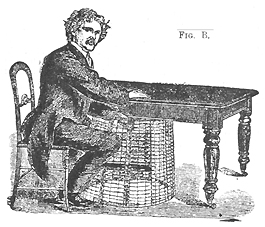 The accordion was now again taken without any visible touch from Mr. Home's hand, which he removed from it entirely and placed upon the table, where it was taken by the person next to him, and seen, as now were both his hands, by all present. I and two of the others present saw the accordion distinctly floating about inside the cage with no visible support. The accordion was now again taken without any visible touch from Mr. Home's hand, which he removed from it entirely and placed upon the table, where it was taken by the person next to him, and seen, as now were both his hands, by all present. I and two of the others present saw the accordion distinctly floating about inside the cage with no visible support.
This was repeated a second time, after a short interval. Mr. Home presently re-inserted his hand in the cage and again took hold of the accordion. It then commenced to play, at first, chords and runs, and afterwards a well-known sweet and plaintive melody, which was executed perfectly in a very beautiful manner. Whilst this tune was being played I grasped Mr. Home's arm, below the elbow, and gently slid my hand down it until I touched the top of the accordion. He was not moving a muscle. His other hand was on the table, visible to all, and his feet were under the feet of those next to him.
Having met with such striking results in the experiments with the accordion in the cage, we turned to the balance apparatus already described. Mr. Home placed the tips of his fingers lightly on the extreme end of the mahogany board, which was resting on the support, whilst Dr. A. B. and myself sat, one on each side of it, watching for any effect which might be produced. Almost immediately the pointer of the balance was seen to descend. After a few seconds it rose again. This movement was repeated several times, as if by successive waves of the Psychic Force. The end of the board was observed to oscillate slowly up and down during the experiment.
Mr. Home now of his own accord took a small
hand-bell and a little card match-box, which- happened to be near, and placed one under each hand, to satisfy us, as he said, that he was not producing the downward pressure. The very slow oscillation of the spring balance became more marked, and Dr. A. B., watching the index, said that he saw it descend to 6 1/2 lbs. The normal weight of the board as so suspended being 3 lbs., the additional downward pull was therefore 3 1/2 lbs. On looking immediately afterwards at the automatic register, we saw that the index had at one time descended as low as 9 lbs., showing, a maximum pull of 6 lbs. upon a board whose normal weight was 3 lbs.
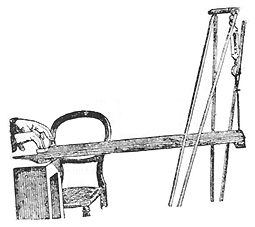 In order to see whether it was possible to produce much effect on the spring balance by pressure at the place where Mr. Home's fingers had been, I stepped upon the table and stood on one foot at the end of the board. Dr. A. B., who was observing the index of the balance, said that the whole weight of my body (140 lbs.) so applied only sunk the index 1 1/2 or 2 lbs. when I jerked up and down. Mr. Home had been sitting in a low easy chair, and could not, therefore, had he tried his utmost, have exerted any material influence on these results. I need scarcely add that his feet as well as his hands were closely guarded by all in the room. In order to see whether it was possible to produce much effect on the spring balance by pressure at the place where Mr. Home's fingers had been, I stepped upon the table and stood on one foot at the end of the board. Dr. A. B., who was observing the index of the balance, said that the whole weight of my body (140 lbs.) so applied only sunk the index 1 1/2 or 2 lbs. when I jerked up and down. Mr. Home had been sitting in a low easy chair, and could not, therefore, had he tried his utmost, have exerted any material influence on these results. I need scarcely add that his feet as well as his hands were closely guarded by all in the room.
This experiment appears to me more striking, if possible, than the one with the accordion. As will be seen on referring to the cut , the board was arranged perfectly horizontally, and it was particularly noticed that Mr. Home's fingers were not at any time advanced more than 1 1/2 inches from the extreme end, as shown by a pencil-mark, which, with Dr. A. B.'s acquiescence, I made at the time. Now, the wooden foot being also 1 1/2 inches wide, and resting flat on the table, it is evident that no amount of pressure exerted within this space of 1 1/2 inches could produce any action on the balance, Again, it is also evident that when the end furthest from Mr. Home sank, the board would turn on the further side of this foot as on a fulcrum. The arrangement was consequently that of a see-saw, 36 inches in length, the fulcrum being 1 1/2 inches from one end; were he, therefore, to have exerted a downward pressure, it would have been in opposition to the force which was causing the other end of the board to move down.
The slight downward pressure shown by the balance when I stood on the board was owing probably to my foot extending beyond this fulcrum.
I have now given a plain, unvarnished statement of the facts from copious notes written at the time the occurrences were taking place, and copied out in full immediately after. Indeed, it would be fatal to the object I have in
view - that of urging the scientific investigation of these phenomena - were I to exaggerate ever so little; for although to my readers Dr. A. B. is at present represented by incorporeal initials, to me the letters represent a power in the scientific world that would certainly convict me if I were to prove an untrustworthy narrator.
In the
Quarterly Journal of Science, October 1st, 1871, the illustrious investigator replied to the charges brought against him by those who were not in agreement with his findings, and recorded a series of further experiments. He wrote: When I first stated in this journal that I was about to investigate the phenomena of so-called Spiritualism, the announcement called forth universal expression of approval. One said that my "statements deserved respectful consideration"; another expressed "profound satisfaction that the subject was about to be investigated by a man so thoroughly qualified as," etc.; a third was "gratified to learn that the matter is now receiving the attention of cool and clearheaded men of recognized position in science"; a fourth asserted that "no one could doubt Mr. Crookes' ability to conduct the investigation with rigid philosophical impartiality"; and a fifth was good enough to tell its readers that "if men like Mr. Crookes grapple with the subject, taking nothing for granted until it is proved, we shall soon know how much to believe."
These remarks, however, were written too hastily. It was taken for granted by the writers that the results of my experiments would be in accordance with their preconceptions. What they really desired was not
the truth, but an additional witness in favour of their own foregone conclusions. When they found that the facts which that investigation established could not be made to fit those opinions, why - "so much the worse for the facts." They try to creep out of their own confident recommendations of the enquiry by declaring that "Mr. Home is a clever conjurer, who has duped us all." "Mr. Crookes might, with equal propriety, examine the performances of an Indian juggler." "Mr. Crookes must get better witnesses before he can be believed." "The thing is too absurd to be treated seriously." "It is impossible, and therefore can't be." (The quotation occurs to
me - "I never said it was possible, I only said it was true.")
"The observers have all been
biologised(!) and fancy they saw things occur which really never took place," etc., etc.
These remarks imply a curious oblivion of the very functions which the scientific enquirer has to
fulfil. I am scarcely surprised when the objectors say that I have been deceived merely because they are unconvinced without personal investigation, since the same unscientific course of
a priori argument has been opposed to all great discoveries. When I am told that what I describe cannot be explained in accordance with preconceived ideas of the laws of nature, the objector really begs the very question at issue, and resorts to a mode of reasoning which brings science to a standstill. The argument runs in a vicious circle: we must not assert a fact till we know that it is in accordance with the laws of nature, while our only knowledge of the laws of nature must be based on an extensive observation of facts. If a new fact seems to oppose what is called a law of nature, it does not prove the asserted fact to be false, but only that we have not yet ascertained all the laws of nature, or not learned them correctly.
I may at once answer one objection which has been made in several quarters, viz., that my results would carry more weight had they been tried a greater number of times, and with other persons besides Mr. Home. The fact is, I have been working at the subject for two years, and have found nine or ten different persons who possess psychic power in more or less degree; but its development in Mr. D. D. Home is so powerful, that, having satisfied myself by careful experiments that the phenomena observed were genuine, I have, merely as a matter of convenience, carried on my experiments with him, in preference to working with others in whom the power existed in a less striking degree. Most of the experiments I am about to describe, however, have been tried with another person than Mr. Home, and in his absence.
Before proceeding to relate my new experiments, I desire to say a few words respecting those already described. The objection has been raised that announcements of such magnitude should not be made on the strength of one or two experiments hastily performed. I reply that
the conclusions were not arrived at hastily, nor on the results or two or three experiments only. In my former paper
(Quarterly Journal of Science, page 340), I remarked: "Not until I had witnessed these facts some half-dozen times, and scrutinized them with all the critical acumen I possess, did I become convinced of their objective reality." Before fitting up special apparatus for these experiments, I have seen on five separate occasions, objects varying in weight from 25 to 100 lbs. temporarily influenced in such a manner, that I, and others present, could with difficulty lift them from the floor. Wishing to ascertain whether this was a physical fact, or merely due to a vibration in the power of our own strength under the influence of imagination, I tested with a weighing machine the phenomenon on two subsequent occasions when I had an opportunity of meeting Mr. Home at the house of a friend. On the first occasion, the increase of weight was from 8 lbs. normally, to 36 lbs., 48 lbs., and 46 lbs., in three successive
experiments tried under strict scrutiny. On the second occasion, tried about a fortnight after, in the presence of other observers, I found the increase of weight to be from 8 lbs., to 23 lbs., 43 lbs., and 27 lbs., in three successive trials, varying the conditions. As I had the entire management of the above mentioned experimental trials, employed an instrument of great accuracy, and took every care to exclude the possibility of the results being influenced by trickery, I was not unprepared for a satisfactory result when the fact was properly tested in my own laboratory. The meeting on the occasion formerly described was, therefore, for the purpose of confirming my previous observations by the application of crucial tests, with carefully arranged apparatus of a still more delicate nature.
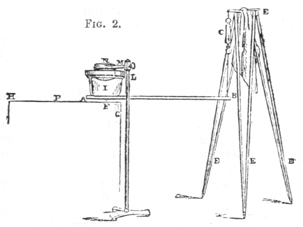 He then proceeds to record further experiments with the medium D. D. Home. On trying experiments (previously recorded) for the first time, I thought that actual contact between Mr. Home's hands and the suspended body whose weight was to be altered was essential to the exhibition of the force; but I found afterwards that this was not a necessary condition, and I therefore arranged my apparatus in the following manner: He then proceeds to record further experiments with the medium D. D. Home. On trying experiments (previously recorded) for the first time, I thought that actual contact between Mr. Home's hands and the suspended body whose weight was to be altered was essential to the exhibition of the force; but I found afterwards that this was not a necessary condition, and I therefore arranged my apparatus in the following manner:
The accompanying cuts (Figs. 8, 9, 10) explain the arrangement. Fig. 8 is a general view, and Figs. 9 and 10 show the essential parts more in detail. The reference letters are the same in each illustration. A B is a mahogany board, 36 inches long by
9 1/2 inches wide and 1 inch thick. It is suspended at the end, B, by a spring balance, C, furnished with an automatic register, D. The balance is suspended from a very firm tripod support, E.
The following piece of apparatus is not shown in the figures. To the moving index, 0, of the spring balance, a fine steel point is soldered, projecting horizontally outwards. In front of the balance, and firmly fastened to it, is a grooved frame carrying a flat box similar to the dark box of a photographic camera. This box is made to travel by clock-work horizontally in front of the moving index, and it contains a sheet of plate-glass which has been smoked over a flame. The projecting steel point impresses a mark on this smoked surface. If the balance is at rest, and the clock set going, the result is a perfectly straight horizontal line. If the clock is stopped and weights are placed on the end, B, of the board, the result is a vertical line, whose length depends on the weight applied. If, whilst the clock draws the plate along, the weight of the board (or the tension on the balance) varies, the result is a curved line, from which the tension in grains at any moment during the continuance of the experiments can be calculated.
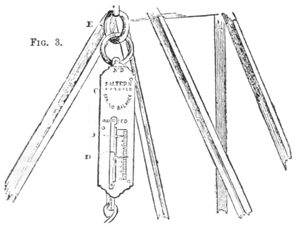 The instrument was capable of registering a diminution of the force of gravitation as well as an increase; registrations of such a diminution were frequently obtained. To avoid complication, however, I will only here refer to in which an increase of gravitation was experienced. The instrument was capable of registering a diminution of the force of gravitation as well as an increase; registrations of such a diminution were frequently obtained. To avoid complication, however, I will only here refer to in which an increase of gravitation was experienced.
The end, B, of the board being supported by the spring balance, the end, A, is supported on a wooden strip, F, screwed across its lower side and cut to a knife edge. This fulcrum rests on a firm and heavy wooden stand, G H. On the board, exactly over the fulcrum, is placed a large glass vessel filled with water, I. L is a massive iron stand, furnished with an arm and ring, M N, in which rests a hemispherical copper vessel perforated with several holes at the bottom.
The iron stand is two inches from the board, A B, and the arm and copper vessel, M N, are so adjusted that the latter dips into the water 1 1/2 inches, being 5 1/2 inches from the bottom of 1, and 2 inches from its circumference. Shaking or striking the arm, M, or the vessel, N, produces no appreciable mechanical effect on the board, A B, capable of affecting the balance. Dipping the hand to the fullest extent into the water in N, does not produce the least appreciable action on the balance.
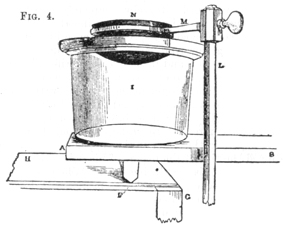 As the mechanical transmission of power is by this means entirely cut off between the copper vessel and the board, A B, the power of muscular control is thereby completely eliminated. As the mechanical transmission of power is by this means entirely cut off between the copper vessel and the board, A B, the power of muscular control is thereby completely eliminated.
For convenience I will divide the experiments into groups, 1, 2, 3, etc., and I have selected one special instance in each to describe in detail. Nothing, however, is mentioned which has not been repeated more than once and in some cases verified, in Mr. Home's absence, with another person possessing similar powers.
There was always ample light in the room where the experiments were conducted (my own dining room) to see all that took
place.
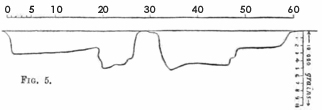 Experiment
One: The apparatus having been properly adjusted before Mr. Home entered the room, he was brought in, and asked to place his fingers in the water in the copper vessel, N. He stood up and dipped the tips of the fingers of his right hand in the water, his other hand and his feet being held. When he said he felt a power, force, or influence, proceeding from his hand, I set the clock going, and almost immediately the end, B, of the board was seen to descend slowly and remain down for about 10 seconds; it then descended a little further, and afterwards rose to its normal height. It then descended again, rose suddenly, gradually sunk for 17 seconds, and finally rose to its normal height, where it remained till the experiment was concluded. The lowest point marked on the glass was equivalent to a direct pull of about
5,000 grains. The accompanying figure is a copy of the curve traced on the
glass. Experiment
One: The apparatus having been properly adjusted before Mr. Home entered the room, he was brought in, and asked to place his fingers in the water in the copper vessel, N. He stood up and dipped the tips of the fingers of his right hand in the water, his other hand and his feet being held. When he said he felt a power, force, or influence, proceeding from his hand, I set the clock going, and almost immediately the end, B, of the board was seen to descend slowly and remain down for about 10 seconds; it then descended a little further, and afterwards rose to its normal height. It then descended again, rose suddenly, gradually sunk for 17 seconds, and finally rose to its normal height, where it remained till the experiment was concluded. The lowest point marked on the glass was equivalent to a direct pull of about
5,000 grains. The accompanying figure is a copy of the curve traced on the
glass.
 Experiment
Two: Contact through water having proved to be as effectual as actual mechanical contact, I wished to see if the power or force could affect the weight, either through other portions of the apparatus or through the air. The glass vessel and iron stand, etc., were therefore removed, as an unnecessary complication, and Mr. Home's hands were placed on the stand of the apparatus at P. A gentleman present put his hand on Mr. Home's hands, and his foot on both Mr. Home's feet, and I also watched him closely all the time. At the proper moment the clock was again set going; the board descended and rose in an irregular manner, the result being a curved tracing on the glass, of which Fig. 12 is a
copy. Experiment
Two: Contact through water having proved to be as effectual as actual mechanical contact, I wished to see if the power or force could affect the weight, either through other portions of the apparatus or through the air. The glass vessel and iron stand, etc., were therefore removed, as an unnecessary complication, and Mr. Home's hands were placed on the stand of the apparatus at P. A gentleman present put his hand on Mr. Home's hands, and his foot on both Mr. Home's feet, and I also watched him closely all the time. At the proper moment the clock was again set going; the board descended and rose in an irregular manner, the result being a curved tracing on the glass, of which Fig. 12 is a
copy.
 Experiment
Three: Mr. Home was now placed 1 foot from the board, A B, on one side of it. His hands and feet were firmly grasped by a bystander, and another tracing, of which Fig. 13 is a copy, was taken on a moving glass
plate. Experiment
Three: Mr. Home was now placed 1 foot from the board, A B, on one side of it. His hands and feet were firmly grasped by a bystander, and another tracing, of which Fig. 13 is a copy, was taken on a moving glass
plate.
 Experiment
Four: (Tried on an occasion when the power was stronger than on the previous occasions). Mr. Home was now placed three feet from the apparatus, his bands and feet being tightly held. The clock was set going when he gave the word, and the end, B, of the board soon descended and again rose in an irregular manner, as shown in Fig.
14. Experiment
Four: (Tried on an occasion when the power was stronger than on the previous occasions). Mr. Home was now placed three feet from the apparatus, his bands and feet being tightly held. The clock was set going when he gave the word, and the end, B, of the board soon descended and again rose in an irregular manner, as shown in Fig.
14.
 The following series of experiments were tried with more delicate apparatus, and with another person, a lady, Mr. Home being absent. As the lady is a non-professional, I do not mention her name. She has, however, consented to meet any scientific men whom I may introduce for purposes of
investigation. The following series of experiments were tried with more delicate apparatus, and with another person, a lady, Mr. Home being absent. As the lady is a non-professional, I do not mention her name. She has, however, consented to meet any scientific men whom I may introduce for purposes of
investigation.
 A piece of thin parchment, A, Figs. 15 and 16, is stretched tightly across a circular hoop of wood. B C is a light lever turning on D. At the end, B, is a vertical needle point touching the membrane, A, and at C is another needle point, projecting horizontally and touching a smoked glass plate, E F. This glass plate is drawn along in the direction, H G, by clockwork, K. The end, B, of the lever is weighted so that it shall quickly follow the movements of the centre of the disc, A. These movements are transmitted and recorded on the glass plate, E F, by means of the lever and needle point, C. Holes are cut in the side of the hoop to allow a free passage of air to the underside of the membrane. The apparatus was well tested beforehand by myself and others, to see that no shaking or jar on the table or support would interfere with the results: the line traced by the point, C, on the smoked glass was perfectly straight in spite of all our attempts to influence the lever by shaking the stand or stamping on the
floor. A piece of thin parchment, A, Figs. 15 and 16, is stretched tightly across a circular hoop of wood. B C is a light lever turning on D. At the end, B, is a vertical needle point touching the membrane, A, and at C is another needle point, projecting horizontally and touching a smoked glass plate, E F. This glass plate is drawn along in the direction, H G, by clockwork, K. The end, B, of the lever is weighted so that it shall quickly follow the movements of the centre of the disc, A. These movements are transmitted and recorded on the glass plate, E F, by means of the lever and needle point, C. Holes are cut in the side of the hoop to allow a free passage of air to the underside of the membrane. The apparatus was well tested beforehand by myself and others, to see that no shaking or jar on the table or support would interfere with the results: the line traced by the point, C, on the smoked glass was perfectly straight in spite of all our attempts to influence the lever by shaking the stand or stamping on the
floor.
Experiment
Five: Without having the object of the instrument explained to her, the lady was brought into the room and asked to place her fingers on the wooden stand at the points L M, Fig. 15. I then placed my hands over hers to enable me to detect any conscious or unconscious movement on her part. Presently percussive noises were heard on the parchment, resembling the dropping of grains of sand on its surface. At each percussion a fragment of graphite which I had placed on the membrane was seen to be projected upwards about 1-50th of an inch, and the end, C, of the lever moved slightly up and down. Sometimes the sounds were as rapid as those from an induction-coil, whilst at others they were more than a second apart. Five or six tracings were taken, and in all cases a movement of the end, C, of the lever was seen to have occurred with each vibration of the membrane.
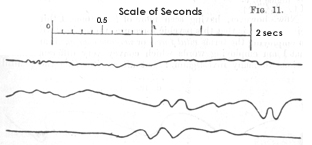 In some cases the lady's hands were not so near the membrane as L M, but were at N O, Fig. 16. In some cases the lady's hands were not so near the membrane as L M, but were at N O, Fig. 16.
The accompanying figure 11 gives tracings taken from the plates used on these occasions.
Experiment
Six: Having met with these results in Mr. Home's absence, I was anxious to see what action would be produced on the instrument in his presence. Accordingly I asked him to try, but without explaining the instrument to him.
I grasped Mr. Home's right arm above the wrist and held his hand over the membrane, about 10 inches from its surface, in the position shown at P, Fig. 16. His other hand was held by a friend. After remaining in this position for about half a minute, Mr. Home said he felt some influence passing. I then set the clock going, and we all saw the index, C, moving up and down. The movements were much slower than in the former case, and were almost entirely unaccompanied by the percussive, vibrations then noticed.
Figs. 18 and 19 show the curves produced on the glass on two of these occasions.
Figs. 17, 18, 19 are magnified.
These experiments
confirm beyond doubt the conclusion at which I arrived in my former paper, namely , the existence of a force associated, in some manner not yet explained, with the human organization, by which force increased weight is capable of being imparted to solid bodies without physical contact. In the case of Mr. Home, the development of this force varies enormously, not only from week to week, but from hour to hour; on some occasions the force is inappreciable by my tests for an hour or more, and then suddenly reappears in great strength. It is capable of acting at a distance from Mr. Home (not
infrequently as far as two or three feet), but is always strongest close to him.
 Being firmly convinced that there could be no manifestation of one form of force, without the corresponding expenditure of some other form of force, I for a long time searched in vain for evidence of any force or power being used up in the production of these results. Being firmly convinced that there could be no manifestation of one form of force, without the corresponding expenditure of some other form of force, I for a long time searched in vain for evidence of any force or power being used up in the production of these results.
Now, however, having seen more of Mr. Home, I think I perceive, what it is that this psychic force uses up for its development. In employing the terms
vital force, or nervous energy, I am aware that I am employing words which convey very different significations to many investigators; but after witnessing the painful state of nervous and bodily prostration in which some of these experiments have left Mr.
Home - after seeing him lying in an almost fainting condition on the floor, pale and
speechless - I could scarcely doubt that the evolution of psychic force is accompanied by a corresponding drain on vital force.
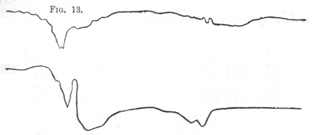 I have ventured to give this new force the name of
Psychic Force, because of its manifest relationship to certain psychological conditions, and because I was most desirous to avoid the foregone conclusions implied in the title under which it has hitherto been claimed as belonging to a province beyond the range of experiment and argument. But having found that it is within the province of purely scientific research, it is entitled to be known by a scientific name, and I do not think a more appropriate one could have been selected. I have ventured to give this new force the name of
Psychic Force, because of its manifest relationship to certain psychological conditions, and because I was most desirous to avoid the foregone conclusions implied in the title under which it has hitherto been claimed as belonging to a province beyond the range of experiment and argument. But having found that it is within the province of purely scientific research, it is entitled to be known by a scientific name, and I do not think a more appropriate one could have been selected.
To witness exhibitions of this force it is not necessary to have access to known psychics. The force itself is probably possessed by all human beings, although the individuals endowed with an extraordinary amount of it are doubtless few. Within the last twelve months I have met in private families five or six persons possessing a sufficiently vigorous development to make me feel confident that similar results might be produced through their means to those here recorded, provided the experimentalist worked with more delicate apparatus, capable of indicating a fraction of a grain instead of recording pounds and ounces
only.
As far as my other occupations will permit, I purpose to continue the experiments in various forms, and I will report from time to time their results. In the meanwhile I trust that others will be induced to pursue the investigation in its scientific form. It should, however, be understood that, equally with all other scientific experiments these researches must be conducted in strict compliance with the conditions under which the force is developed. As it is an indispensable condition of experiments with frictional electricity that the atmosphere should be free from excess of moisture, and that no conducting medium should touch the instrument while the force is being generated, so certain conditions are found to be essential to the production and operation of the Psychic Force, and unless these precautions are observed the experiments will fail. I am emphatic on this point, because unreasonable objections have sometimes been made to the Psychic Force that it is not developed under adverse condition dictated by the experimentalist, who, nevertheless, would object to conditions being imposed upon himself in the exhibition of any of his own scientific results. But I may add that the conditions required are very few, very reasonable, and in no way obstruct the most perfect observation and the application of the most rigid and accurate tests.
__________________________________
Just before going to press I have received from my friend, Professor Morton, an advance sheet of the Journal of the Franklin Institute, containing some remarks on my last paper by Mr. Coleman Sellers, a leading scientific engineer of the United States. The essence of his criticism contained in the following
quotation:
"On page 341 (of the
Quarterly Journal of Science) we have given a mahogany board 36 inches long by 9 1/2 inches wide, and
1 inch thick, with at each end a strip of mahogany 1 1/2 inches wide screwed on, forming feet. This board was so placed as to rest with one end on the table, the other suspended by a spring balance, and, so suspended, it recorded a weight of 3 pounds; i.e., a
mahogany board of the above dimensions is shown to weigh 6 pounds
- 3 pounds on the balance, and 3 pounds on the table. A mechanic used to handling wood wonders how this may be. He looks through his limited library, and finds that scientific men tell him that such a board should weigh about 13 1/2 pounds. Did Mr. Crookes make this board himself, or did Mr. Home furnish it as one of his pieces of apparatus?... It would have been more satisfactory if Mr. Crookes had stated, in regard to this board, who made
it... Let it be discovered that the 6 pound mahogany board was furnished by Mr. Home, and the experiments will not be so
convincing."
My experiments must indeed be convincing if so accomplished a mechanician as Mr. Coleman Sellers can find no worse fault with them than is expressed in the comments I have quoted. He writes in so matter-of-fact a manner, and deals so plausibly with dimensions and weights, that most persons would take it for granted that I really
had committed the egregious blunder he points out.
Will it be believed, therefore, that my mahogany board does weigh only 6 pounds?
Four separate balances in my own house tell me so, and my greengrocer confirms the fact.
It is easy to perceive into what errors a "mechanic" may fall when he relies for practical knowledge on his "limited library," instead of appealing to actual experiment.
I am sorry I cannot inform Mr. Sellers who made my mahogany board. It has been in my possession about sixteen years; it was originally cut off a length in a
wood-yard; it became the stand of a spectrum camera, and as such is described with a cut in the Journal of the Photographic Society for January 21, 1856 (vol. II page 293). It has since done temporary duty in the arrangement of various pieces of apparatus in my physical laboratory, and was selected for these particular experiments owing to its shape being more convenient than that of other available pieces of wood.
But is it seriously expected that I should answer such a question as "Did Mr. Home furnish the board?" Will not my critics give me credit for the possession of some amount of common
sense?
Contents
| Next | Previous
|

